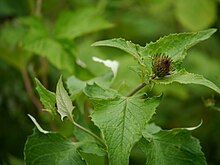Aucklandia lappa
| Saussurea costus | |
|---|---|
 |
|
| Scientific classification | |
| Kingdom: | Plantae |
| (unranked): | Angiosperms |
| (unranked): | Eudicots |
| (unranked): | Asterids |
| Order: | Asterales |
| Family: | Asteraceae |
| Tribe: | Cynareae |
| Genus: | Saussurea |
| Species: | S. costus |
| Binomial name | |
|
Saussurea costus (Falc.) Lipsch. |
|
| Synonyms | |
|
|
Saussurea costus, commonly known as costus or kuth, is a species of thistle in the genus Saussurea native to South Asia. Essential oils extracted from the root have been used in traditional medicine and in perfumes since ancient times. Saussurea Costus falls within the Kingdom: Plantae, Phylum: Tracheophyta, Class: Magnoliopsida, Order: Asterales, Family: Compositae. The genus Saussurea belongs to Asteraceae which comprises about 300 species in the world (Bremer, 1994) of which 61 species are found in India. Aucklandia, also known as costus or Mu Xiang, is the root of the plant Saussurea costus. The root of the plant is the key part used for medicinal or homeopathic purposes.
It has a large number of names in other languages, including kustha in Sanskrit; kust or qust in Arabic and Persian; kut, kur, and pachak in Hindi and Bengali, kostum, gostham, and potchuk in Tamil; upaleta and kur in Gujarati; kot or kust in Punjabi; changala in Telugu; sepuddy in Malayalam; kostha in Kannada; kuth or postkhai in Kashmiri; and kosht (קשט) in Hebrew.
The plant is cultivated as a medicinal plant. Its growing region occurs mainly within India-Himachal Pradesh, Jammu-Kashmir- its native place of origin. A study by Parmaret. al. 2012 explored the effect of altitude on seed germination and survival percentage, proving that high altitudes favoured high survival and seed germination percentages. This is why they thrive so abundantly in the Himalayan Region which is very mountainous. Cultivation is primarily focused upon the roots of the plants. Most of the roots are exported to China and Japan and as they serve as a big commodity for commerce in Kashmir. However, this type of trade is now being controlled by the state due to it being over-exploited. This plant has been greatly over-collected and recently was placed on the CITES I list of endangered species making it now illegal to dig them up for export.
...
Wikipedia
